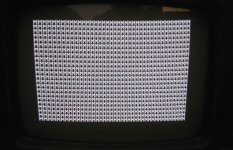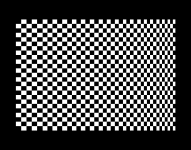I replaced C23/C24/C25, but there's no noticeable difference, which is what I was expecting since they are only for decoupling. I don't have a suitable non-polarised cap for C28, so I refitted the original since it was well within spec according to the LCR meter.
Would it be worth trying to fit a linearity coil? I can probably dig out something suitable from my parts box.
You could try one, it would be a type preferably with an adjustment of the permanent magnet within it (many types were fixed at the factory) and made for a set with a similar sized CRT.
However when the linearity is corrected there will be a loss of raster width, greater on the left than right and the raster centering magnets will need adjusting.
With the width issue, when there is no width inductor, it usually means for the combination power supply voltage, yoke & CRT, that the makers were struggling to get full width and in the case where there is not a suitable tap nearby on the LOPT primary to get more width back, the only way to increase it is to increase the supply voltage to the H output stage, that also increases the EHT, so it is unwise to do that more than about 10 to 15%.
I see there is an unused tap on the LOPT nearby that would have a higher level, possibly that would work with both a lin coil and width coil added, but, I'm not sure, you would need to check with the scope. Also any added width or lin coil ideally has the lowest possible DC resistance. Normally these have fairly thick wire at least 0.5 to 0.7mm diameter.
Overall, since the linearity error is small, I would suggest just leaving it as is and accept it as one of the interesting vagaries of these old monitors.
(On the issue of capacitors being for coupling or decoupling, or the distinction between the application, it makes no difference in power stages like this because power is taken from the supply, via the HOT and returned to the supply via the energy recovery rectifier during the H scanning cycle, so if the internal resistance of the power supply increases, due to aged capacitors, it has similar and near identical effects to the yoke coupling capacitor going high ESR as both introduce resistance into the pathway affecting the yoke current. Usually, for most monitors, the yoke coupling caps or S sorrection caps for the H coils are special quality and don't fail very often, but they more often do for the V coils as they are common garden electrolytic types)


